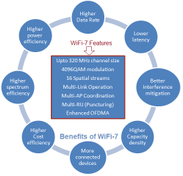
802.11ac Wi-Fi: Advantages and Disadvantages
Explore the pros and cons of the 802.11ac Wi-Fi standard, including its key features, benefits like gigabit speeds, and drawbacks like lack of 2.4 GHz support.
Showing 20 posts (Page 1 of 2)
Advertisement

Explore the pros and cons of the 802.11ac Wi-Fi standard, including its key features, benefits like gigabit speeds, and drawbacks like lack of 2.4 GHz support.
Compare WLAN standards 802.11n and 802.11ax (Wi-Fi 6). Explore their specifications, features, modulation schemes, and data rates for a clearer understanding.

Learn about Belkin WeMo, a home automation network using Wi-Fi for communication between devices. Discover its features and how it works as a star network.
D-Link selects Broadcom's StrataGX processor and 5G WiFi SoC to enhance its 802.11ac access points, boosting processing power and reducing energy use.

Compare ESP32 and ESP8266 Wi-Fi boards. Explore features, similarities, and differences to help you choose the right one for your project.
Explore the differences between femtocells and Wi-Fi for indoor wireless connectivity, focusing on coverage, cost, and use cases to determine the best solution.
Explore the evolution of IEEE 802.11 standards (Wi-Fi), from legacy versions to the latest Wi-Fi 6 and upcoming Wi-Fi 7, detailing their features, data rates, and applications.
Explore the IEEE 802.11ax standard, also known as High-Efficiency WLAN (HEW) or superfast Wi-Fi, and its key features.

Explore leading WiFi 6E chipset manufacturers like Broadcom and Qualcomm, driving advancements in speed, capacity, and performance for the latest wireless technology.

Explore the fundamental differences between Li-Fi and Wi-Fi technologies, including architecture, range, speed, and applications.
Explore the distinctions between Miracast and Wi-Fi, both based on IEEE 802.11, but differing in connection methods. Miracast uses Wi-Fi Direct for direct connections, while Wi-Fi relies on an access point.
A concise comparison of NFC, RFID, Bluetooth, and Wi-Fi technologies, highlighting their range, frequency, data rate, communication type, and applications.
Explanation of the term 'Wi-Fi -1', its components, and usage within WLAN. Covers basics of Wi-Fi technology and related RF concepts.

Explore the MCS table in Wi-Fi 7 (IEEE 802.11be), detailing how modulation, coding, spatial streams, and bandwidth impact data rates for optimized wireless communication.

Explore the pros and cons of Wi-Fi 7 (IEEE 802.11be), including its high speeds, reduced latency, increased complexity, and power consumption.

Learn about Wi-Fi Direct technology, which enables direct Wi-Fi connections between devices without an access point. Explore its benefits and applications.
Explore the differences between WiFi 6, WiFi 6E, and WiFi 7, including speed, features, and use cases, to understand which wireless technology best suits your needs.

Explore WiFi 7 architecture, including PHY/MAC layer enhancements, MLO, and benefits like higher data rates, reduced latency, and improved spectrum efficiency.

Explore the benefits and drawbacks of WiFi offloading in cellular networks. Learn how it reduces traffic, improves user experience, and the challenges it presents.

Learn about the IEEE 802.11ac Wi-Fi 5 standard, its features, frame structure, physical and MAC layers, and radio network planning.
Advertisement